I am finished, and you should read my previous posts about this game before getting to this one.
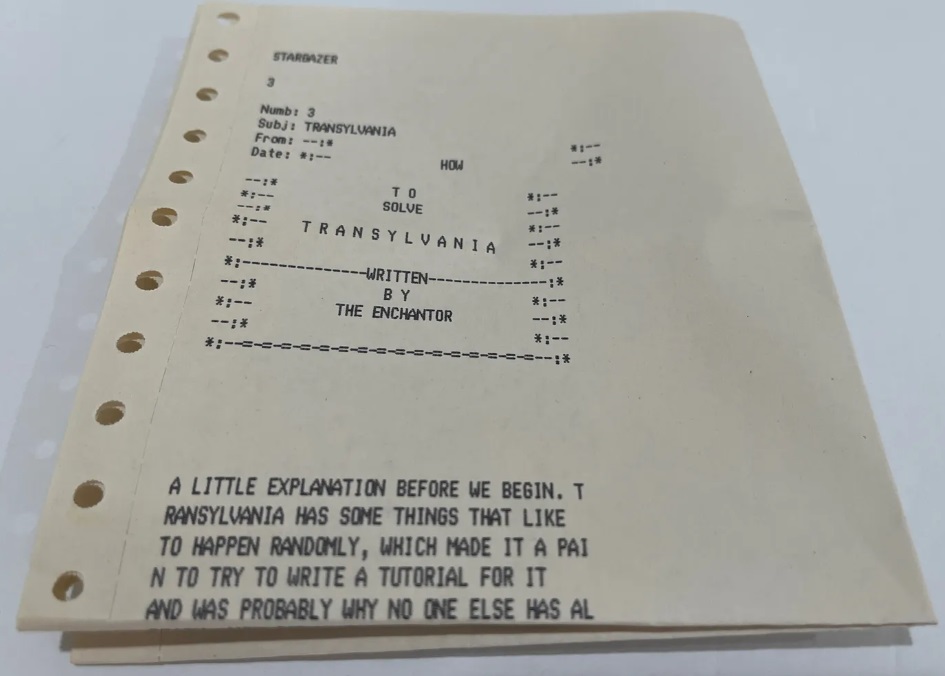
Old printed walkthrough that comes with a copy of Transylvania on eBay.
I almost managed the feat of being able to say Transylvania pulled off not having any jank puzzles, but alas, I ended up looking up how to deal with the moose head.
Before doing that, though, I realized I could RIDE BROOM. This results in a colorful description of flying through the air before crashing in a tree.
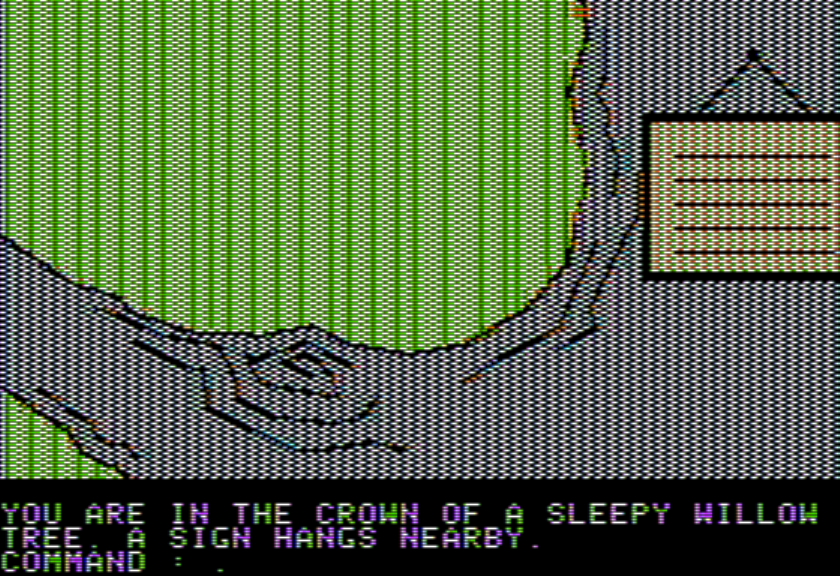

This is only a hint for the cabin insofar as indicating it is important. This would have been a perfect opportunity for a little more detail, to avoid having the player refer to a second-order object on the moose head itself, and PULL ANTLERS.

I suspect the original text version was just fine, but the author got tempted by not only having the head only be rendered visually but making the player refer to the antlers as an entirely separate object.
Searching the cloak finds a lock pick. I took that over to the door at the cave (which I suspected might stay closed, but I guess not) and popped it open to find a cave with a crystal ball.

The crystal ball can’t be taken, just looked at. It reveals a figure wearing a wizard’s cloak (check) and a shiny gold ring (check) and waving the ring at the statue. In other words, waving the ring (which I had tried many places) does work, I just needed to be wearing the wizard cloak too (which I had just found) in order for it to activate.

This reveals an alien creature who says he is “deeply indebted” to you and then crushes your ring.
It is possible to get a little stuck from here because now you just need to wait for time to pass. Eventually you see a “shooting star”.
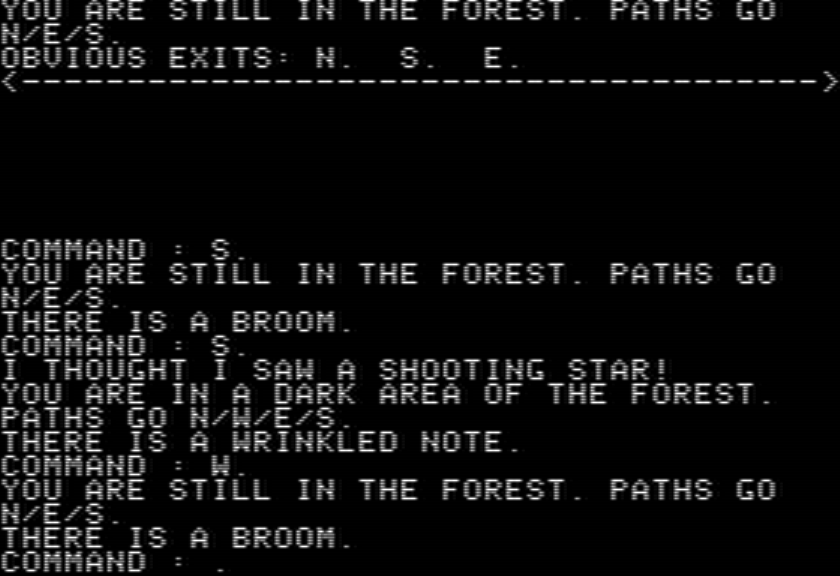
After doing so you can head back to the place with the statue and find a new encounter, a flying saucer.
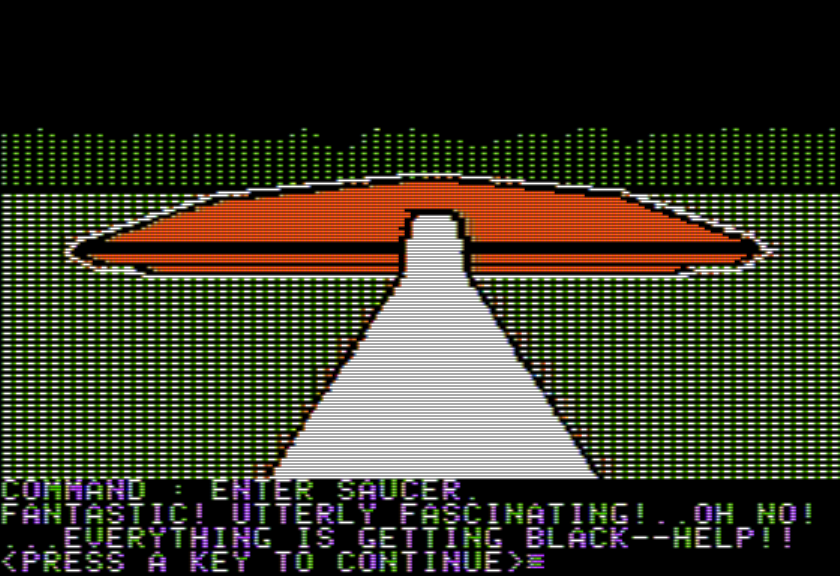
This scene leaves you with a mysterious black box with a button. But this is exactly what you need to win, as the button serves to open the sarcophagus with the princess.

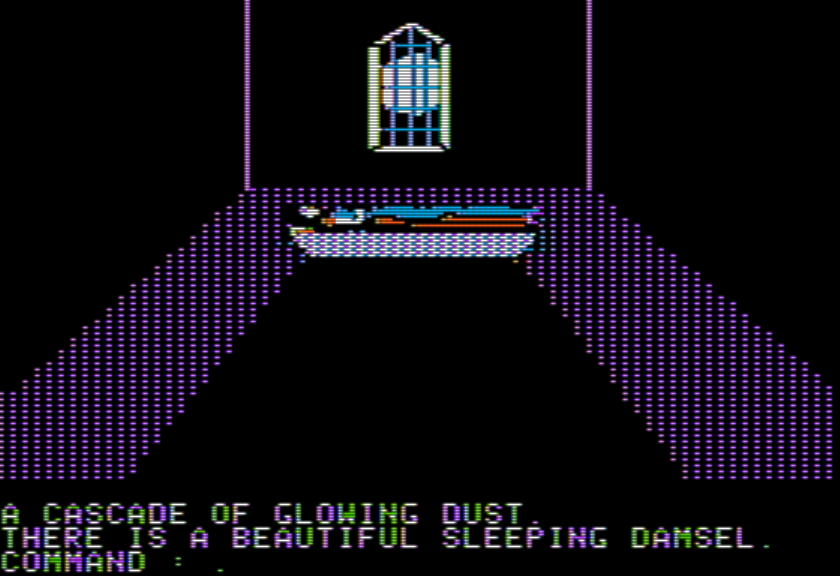
Now winning is just a matter of following the directions from the book: wave elixir, pour elixir, and clap hands.

Before getting to the end, a digression.
I’ve come across many people for whom Transylvania is one of their core childhood memories; Jimmy Maher makes it one of the rare early graphical adventures on his Hall of Fame list. So people certainly remember this one fondly, and…
…actually, I was just fine with it, antlers notwithstanding. This clearly was intended as a romp, and one that had appeal to children (attested by many childhood recollections I’ve read) so I’m not going to ding too much on the simplistic writing.
The game design was curiously open and mostly attempted to be “easy”, but that’s far better than the games we’ve seen (ahem The Mask of the Sun) that try to add very hard elements.
Speaking of The Mask of the Sun, I’d like to go double-meta for a moment, as I found this thread while searching around for reviews at the intfiction forum. It’s about Apple II graphical adventures as a whole.
I couldn’t believe I saw them again. They were all terrible adventure games. The writing is especially awful. The art was mind blowing at the time, especially because I understood the advances in Apple II programming that were producing the art in these games…
I really remembered Mask of the Sun, and I was excited to watch it be played on YouTube, and then, it was really terrible IF. It starts with a story, and then it’s a lot of maze, of roads. Solve maze, go inside, new maze. Almost at random, you get to put a thing from one place to another place.
Especial reward, an animation that was not possible on Apple II. Oh, that’s why I remember it.
— J. Robinson Wheeler
There is the general implication (not just this quote, but elsewhere) that these games are only good for nostalgia. Mask of the Sun indeed had some design issues which I went into, but it’s certainly not true that every game is bad in the same way.
When I write these things, I want to distinguish between things in a old style that you have to grant to move forward, and things that are genuinely bad regardless of style. An inventory limit is an example of the former: there’s nothing technically inherently wrong with one, and not having one means you miss out on puzzles like Magic Mirror or Adventure Quest had. Eventually games started to get so much inventory that they started to obtain a “rucksack” style object, but this is not just good or bad, but a tradeoff.
On the other hand, something like the antlers being separate is a bad design choice overall, even compared to other games of the time (which did not necessarily do such a thing).
One of the ways paradigm shifts in gaming happen is to revive one of the previously “bad” elements with a twist. If I told you about a game that is timed and you have to keep starting from the beginning to win, you might think I meant an NES game, but I also mean the multi-award-winning Outer Wilds. Part of what Dark Souls did was simply restore the idea that the difficulty of a game can push back, and the “troll level” in Mario Maker came from a similar re-think of the rules of game design. We shouldn’t think of our current state of game design as perfected and older design as regressive: there are different expectations and design goals that can be met.
Referring back to Transylvania, the time limit and inventory limit (onerous to modern players) clearly are meant to have a particular effect, and it was on hour 4 that I finally went to triumph with the princess, which made it satisfying in a way that would otherwise be hard to duplicate.

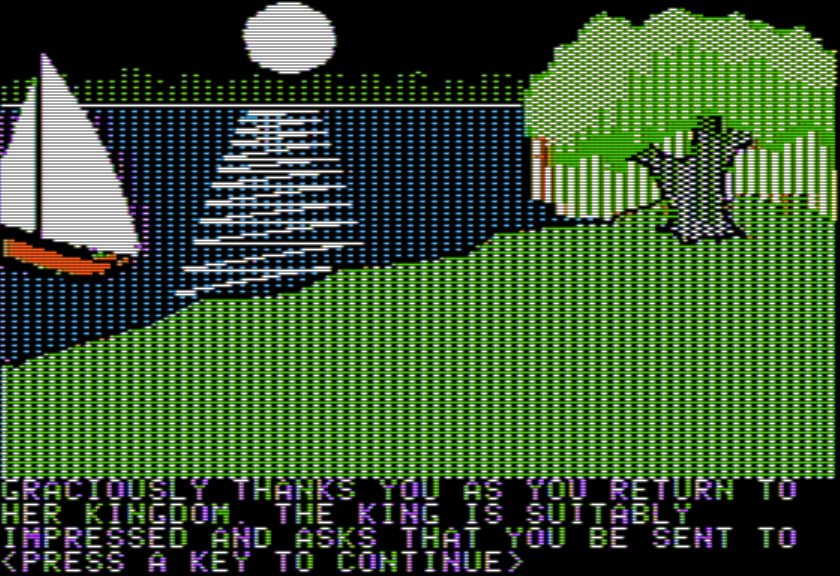


There is a sequel, although it goes in a different direction: the hero from this game, Princess Sabrina, and Prince Erik find a vampire lord has killed King John the Good. You can switch characters while playing. That doesn’t seem to match the ending here, so maybe alternate universe? In any case, we’ll need to wait a while before arriving at The Crimson Crown.
Great coverage here, as always!
As a long-time collector of old Japanese gaming magazines, and someone who was more or less au courant with that market at the time, I recall that this game also had a noticeable presence in the early Japanese adventure game scene. When companies like Falcom, Starcraft and Hummingbird Soft were heavily involved in importing US Apple II games into Japan, this one seemed to be a relatively big seller, and got plenty of magazine coverage, before becoming one of Starcraft’s more popular ports to the Japanese systems of the day. I generally had the impression that, after On-Line’s Mystery House and Wizard & the Princess, Transylvania was perhaps the next most prominent title that really introduced and popularized these text/graphic adventures over there, which had a good run of popularity for a few years in the 80s.
One other thing: Do you know how different the later Polarware version was? I’m not sure I was aware they had altered/added content to the game, until I saw you mention it.
Adam linked a playthrough which mentioned a basement in the house and a very weird … copy protection puzzle?
https://bluerenga.blog/2024/05/27/transylvania-slowly-its-outline-changes-to-that-of-a-decrepit-old-man/#comment-100688
I haven’t played the Polarware one, although I have of the sequel (I got it when it was fairly new-ish).
ADD: You also might want to look at some of the shots from the high-res version which didn’t change much otherwise, there are some at Data Driven Gamer:
https://datadrivengamer.blogspot.com/2020/06/game-196-transylvania.html
This Wheeler seems determined to prove why just because you were old and you were there you aren’t necessarily wise. Not a lot of talk about gameplay there, outside of the low hanging fruit of mazes. I’m not the kind of person who says that if you want a story you should read a book, but you can make a good game with a crap story and people will play it; You can’t say the same about a crap game with a good story. (Before anyone gives me counter examples, consider that I said crap, not mediocre, we’re not talking bland gameplay, we’re talking actively user hostile or unfriendly)
I think the troll level you’re referring to actually came from the Kazio Mario kind of games, but I don’t quite know what you’re thinking about. Anyway, time limits, I think that’s a good idea that simply got hit with the fact that today we want to finish games as fast as possible, but we don’t actually want to be timed in that way. The idea of a time limit produces panic even if we would reach the time beforehand. Transylvania, to me, honestly doesn’t fit in with any complaints about the time limit, because you have more than enough time to win the game that you’d kind of have to try to. Even if you didn’t, it’s not that much effort to restart the game and do everything you already know, unlike other games with time limits.
btw, Rob Wheeler has worked on quite a few games, First Things First is probably the one of most interest to people on this blog
https://ifdb.org/search?searchfor=author%3AJ.+Robinson+Wheeler
He also contributed to the compilation works Pick Up the Phone Booth and Aisle and Coke Is It which have come up on this blog before.
Anyway, I think the criticism of Mask of the Sun is essentially fair. I have the extra caveat that the moves it did were _interesting_ and essentially new for the time period, and I think the aspect a lot of people miss (and what Rob was missing in that message) is when that new-ness happens, it all clumps together, and you start to think all the games are like that.